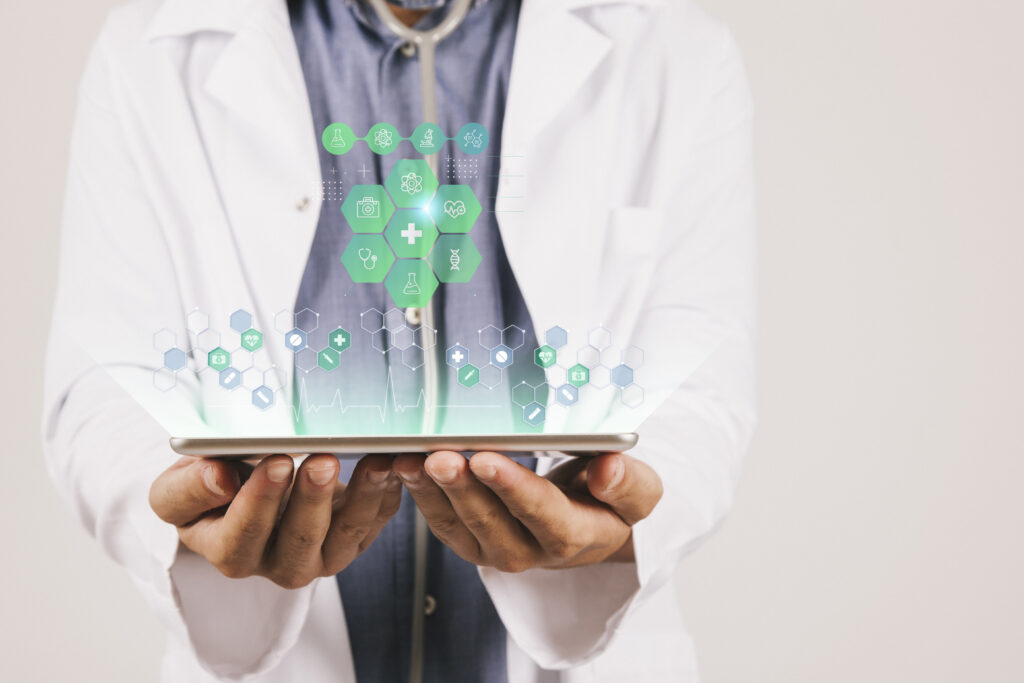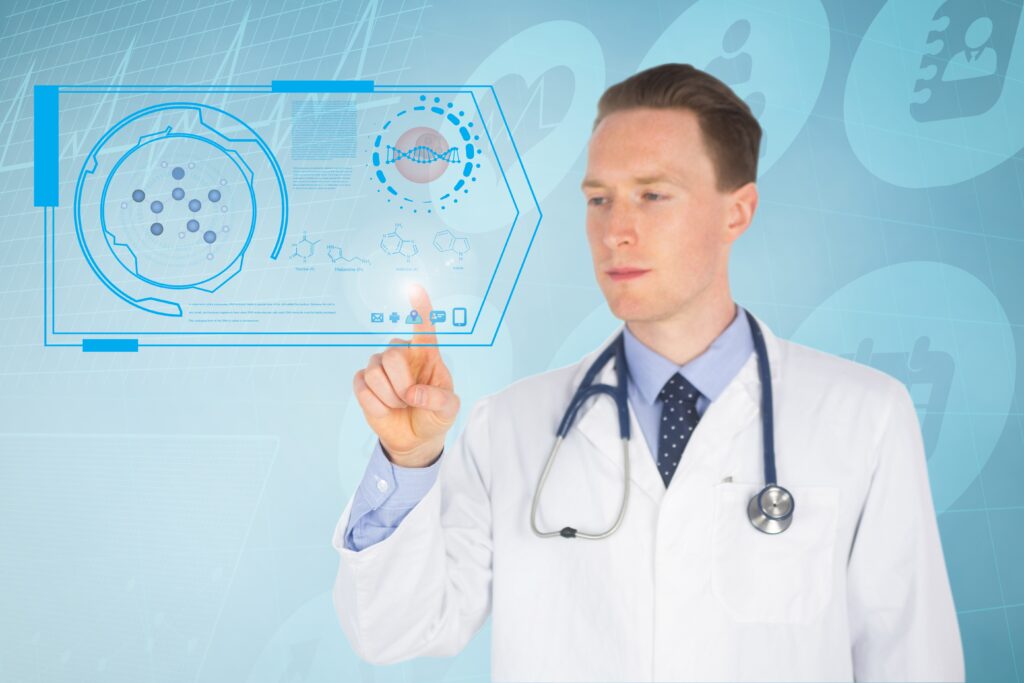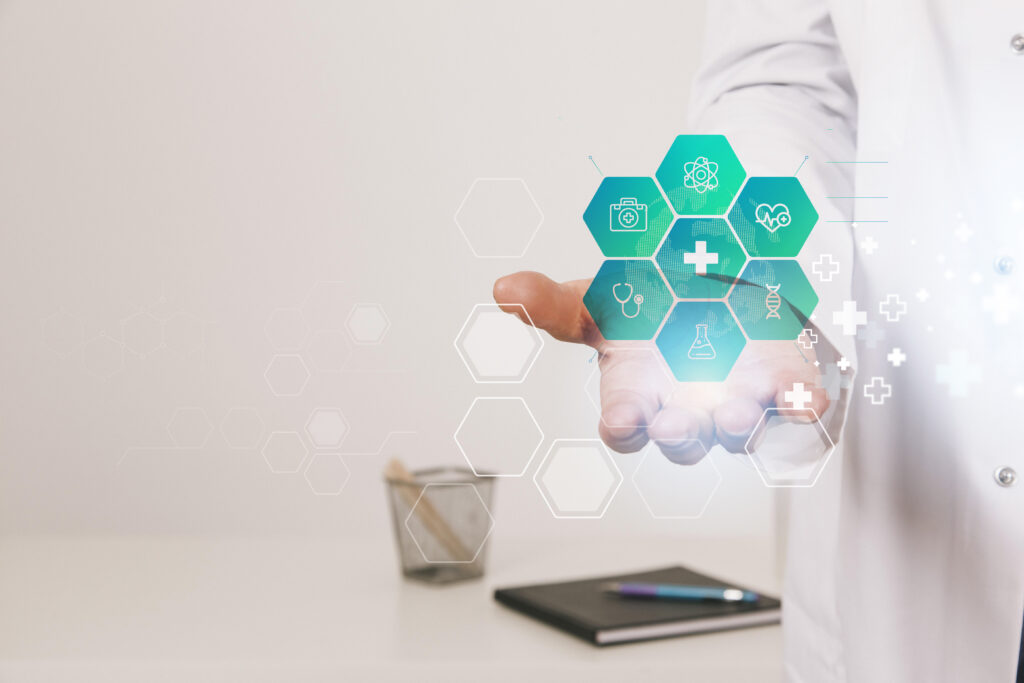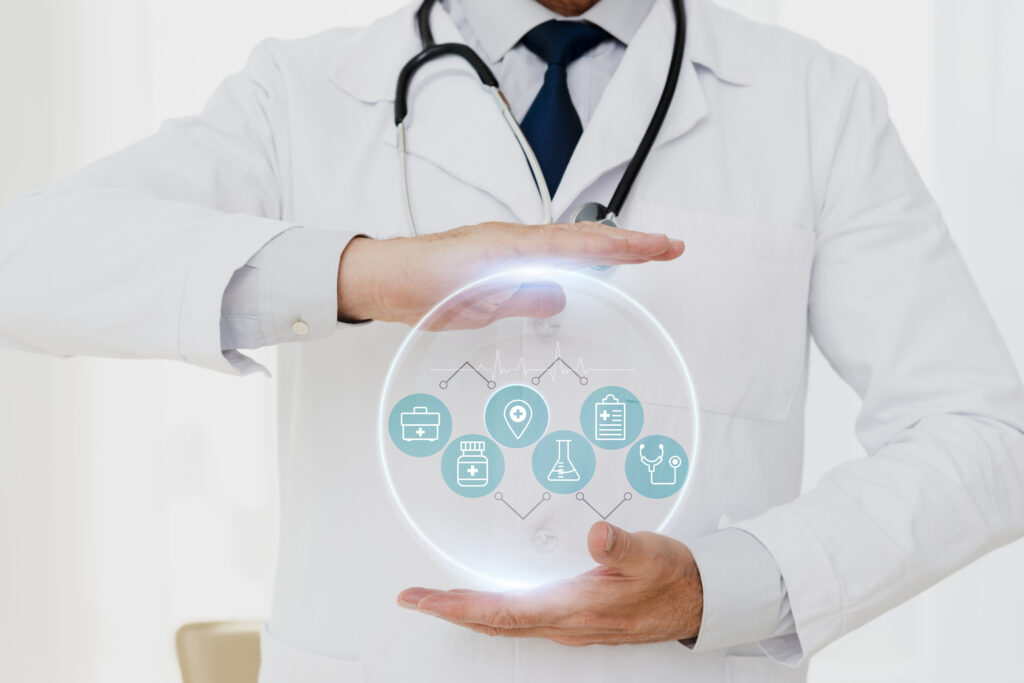Introduction

Image by Freepik
In an age where technology permeates nearly every facet of our lives, it’s no surprise that the realm of healthcare has also undergone a digital transformation. Information Technology (IT) has become an invaluable tool in revolutionizing the way we approach healthcare delivery, from patient care to administrative processes. In this blog post, we’ll delve into the fascinating world of “Information Technology in Health.” We’ll explore how IT has reshaped healthcare, the role of telemedicine, the significance of Electronic Health Records (EHRs), the impact of Artificial Intelligence (AI), and much more. By the end of this journey, you’ll have a deeper understanding of how IT is enhancing healthcare and what the future holds for this dynamic field.
I. The Digital Transformation of Healthcare

Image by Freepik
In the not-so-distant past, healthcare was synonymous with paper records, handwritten prescriptions, and manual administrative tasks. Enter the digital era, and everything changed. Information Technology in Health, also known as Health IT, has ushered in a new era of efficiency, accuracy, and accessibility.
Electronic Health Records (EHRs) have been at the forefront of this transformation. These digital repositories of patient information have replaced traditional paper records in healthcare facilities worldwide. They offer numerous advantages, such as instant access to patient histories, streamlined communication among healthcare providers, and improved accuracy in documentation. This transition has had a profound impact on patient care, reducing errors, and ensuring that vital information is readily available to healthcare professionals.
Moreover, IT has brought about a significant improvement in administrative processes, from scheduling appointments to billing and insurance claims. Automation and digital tools have streamlined these tasks, reducing administrative burdens on healthcare staff and improving the overall patient experience.
II. Telemedicine and Remote Health Monitoring

Image by Freepik
Telemedicine, a subset of Health IT, has gained considerable traction in recent years, especially in light of the COVID-19 pandemic. It involves remote medical consultations using video conferencing and other digital communication tools. Telehealth services have revolutionized healthcare access, particularly for individuals in remote or underserved areas.
One of the significant benefits of telemedicine is the convenience it offers. Patients can consult with healthcare providers from the comfort of their homes, reducing the need for travel and waiting times. This accessibility has proven invaluable during public health crises, allowing for the continuation of essential healthcare services while minimizing the risk of virus transmission.
Additionally, telemedicine goes hand in hand with remote health monitoring. Wearable devices, such as smartwatches and fitness trackers, enable individuals to track vital signs, physical activity, and even detect irregularities in real-time. These devices can send data to healthcare providers, allowing for proactive intervention and personalized care plans.
III. Electronic Health Records (EHRs) and Data Interoperability

Image by Freepik
Electronic Health Records (EHRs) have become the backbone of modern days healthcare. They consolidate patient data, including medical histories, diagnoses, medications, and treatment plans, into secure digital records. These records are accessible to authorized healthcare providers, ensuring seamless continuity of care.
One of the critical aspects of EHRs is data interoperability—the ability of different EHR systems to exchange and use patient data. Interoperability is essential for providing high-quality care, as it allows healthcare providers to access a patient’s complete medical history regardless of where they’ve received treatment.
However, achieving full data interoperability remains a challenge in the healthcare industry. Different EHR systems may use different data standards and formats, making seamless data exchange complex. Efforts are ongoing to standardize data sharing and promote interoperability to improve patient care coordination.
IV. Artificial Intelligence and Machine Learning in Healthcare

Image by Freepik
The integration of Artificial Intelligence (AI) and Machine Learning (ML) into healthcare has opened new frontiers in diagnostics, treatment planning, and patient care. AI algorithms can analyze vast datasets with unparalleled speed and accuracy, making them valuable tools for healthcare professionals.
One of the most significant applications of AI in healthcare is medical imaging in now days. AI algorithms can interpret medical images, such as X-rays, MRIs, and CT scans, with remarkable precision. This technology aids radiologists in detecting abnormalities, speeding up diagnosis, and improving patient outcomes.
Additionally, AI-driven predictive analytics can help identify individuals at risk of specific diseases. By analyzing patient data, AI algorithms can predict disease onset, allowing for early intervention and prevention strategies. This proactive approach has the potential to save lives and reduce healthcare costs.
However, the adoption of AI in healthcare also raises ethical considerations. Who is responsible when AI makes medical decisions? How do we ensure fairness and transparency in algorithms? These are questions that must be carefully addressed as AI continues to evolve in the healthcare sector.
V. Cybersecurity and Data Privacy in Health IT

Image by creativeart on Freepik
The digitization of healthcare data has brought significant benefits but has also raised concerns about cybersecurity and data privacy. With sensitive patient information stored electronically, the healthcare industry has become a prime target for cyberattacks.
Securing patient data is paramount, given the potential consequences of breaches. Unauthorized access to medical records can lead to identity theft, fraud, and even compromised patient care. Regulatory frameworks like the Health Insurance Portability and Accountability Act (HIPAA) in the United States require healthcare organizations to implement safeguards to protect patient data.
Moreover, healthcare professionals must prioritize data privacy and obtain informed consent when using patient data for research or treatment. Patients have the right to know how their data is used and shared, and ethical considerations play a vital role in maintaining trust in the healthcare system.
VI. Patient Empowerment and Engagement

Information Technology in Health extends beyond the clinical setting; it empowers patients to take control of their health. Patient portals and health apps enable individuals to access their medical records, schedule appointments, and communicate with healthcare providers online.
These digital tools also serve as valuable resources for health information. Patients can research medical conditions, access educational materials, and gain a better understanding of their health. This empowerment leads to more informed decision-making and improved health outcomes.
Furthermore, digital communication channels facilitate patient-provider interactions. Telehealth visits, secure messaging, and virtual consultations enhance patient engagement and promote ongoing communication. Lots of Patients are no longer passive recipients of care; they are active participants in their health journeys.
VII. Challenges and Ethical Considerations
While Information Technology in Health offers immense potential, it comes with its share of challenges and ethical dilemmas:

Image by Freepik
1. Digital Divide:
Not everyone has equal access to technology and digital healthcare services. Addressing the digital divide is crucial to ensure that all individuals, regardless of their socioeconomic status or location, can benefit from Health IT.
2. Ethical AI:
The use of AI in healthcare raises ethical questions, such as transparency, accountability, and bias. Ensuring that AI systems make fair and ethical decisions is an ongoing concern.
3. Data Ownership:
Determining who owns and controls patient data is a complex issue. Patients, healthcare providers, and technology companies may all have stakes in this valuable resource.
4. Informed Consent:
Obtaining informed consent for the use of patient data in research or treatment is a critical ethical consideration. Patients must understand how their data will be used and have the option to opt in or out.
VIII. The Future of Health IT
The future of Information Technology in Health is bright and promises even more advancements:

Image by Freepik
1. Virtual Reality (VR) and Augmented Reality (AR):
VR and AR are poised to transform medical education and training, offering immersive learning experiences for healthcare professionals.
2. Blockchain:
Blockchain technology holds potential for secure and transparent health data sharing, safeguarding patient privacy while ensuring data integrity.
3. Personalized Medicine:
Advancements in genomics and AI will enable personalized treatment plans tailored to individual patients, optimizing healthcare outcomes.
In conclusion, Information Technology in Health has revolutionized healthcare delivery, offering benefits such as improved patient care, telemedicine access, and enhanced data management. While challenges and ethical considerations exist, the potential for continued innovation in the field is vast. By embracing the possibilities and addressing the complexities, we can harness the full power of Health IT to create a healthier and more connected future for all.

Image by rawpixel.com on Freepik
FAQs – Information Technology in Health
Q1: What is Information Technology in Health (Health IT)?
A1: Health IT, or Information Technology in Health, refers to the use of digital tools, software, and systems to manage, store, and exchange health-related information. It encompasses electronic health records, telemedicine, AI applications, and more, all aimed at improving healthcare delivery and patient outcomes.
Q2: How has Health IT transformed healthcare?
A2: Health IT has transformed healthcare by digitizing patient records, enabling telemedicine for remote consultations, improving data management, and enhancing patient engagement. It has also accelerated medical research and diagnostics through AI and machine learning.
Q3: What are the benefits of telemedicine?
A3: Telemedicine offers benefits such as improved access to healthcare, reduced travel times, and increased convenience. It’s particularly valuable in remote or underserved areas and during public health crises.
Q4: What are Electronic Health Records (EHRs), and why are they important?
A4: EHRs are digital records that consolidate patient health information, making it easily accessible to healthcare providers. They improve care coordination, reduce errors, and enhance patient safety by ensuring that critical information is readily available.
Q5: How does AI impact healthcare?
A5: AI in healthcare aids in medical imaging interpretation, disease prediction, personalized treatment plans, and more. It accelerates diagnostics, improves decision-making, and enhances patient care. However, ethical considerations in AI adoption are crucial.
Q6: What are the cybersecurity challenges in Health IT?
A6: Cybersecurity challenges include protecting patient data from breaches, ensuring compliance with data protection regulations like HIPAA, and safeguarding against unauthorized access. Maintaining patient trust is paramount.
Q7: How can patients benefit from Health IT?
A7: Patients can benefit from Health IT by accessing their medical records, scheduling appointments online, and engaging in virtual consultations. It also empowers them with health information resources and facilitates communication with healthcare providers.
Q8: What is the future of Health IT?
A8: The future of Health IT holds promises of virtual reality and augmented reality applications in medical education, blockchain for secure data sharing, and personalized medicine tailored to individual patients. Continued innovation is on the horizon.
Conclusion
Information Technology in Health is not just a tool; it’s a transformative force reshaping the way we perceive and experience healthcare. As we journeyed through this exploration, we discovered how IT has digitized medical records, extended healthcare access through telemedicine, harnessed AI for precision diagnostics, and empowered patients to become active participants in their health journeys.
The digital transformation of healthcare, epitomized by Electronic Health Records (EHRs), has streamlined patient care, reduced errors, and improved the efficiency of healthcare systems. Patients now have their medical histories at their fingertips, and healthcare providers can access vital information quickly.
Telemedicine and remote health monitoring have broken down geographical barriers, making healthcare accessible to even the most remote areas. It’s not just about convenience; it’s about ensuring that everyone has the opportunity to receive quality care.
Artificial Intelligence and Machine Learning have stepped into the realm of healthcare, enabling more accurate and timely diagnostics. From medical imaging to predictive analytics, AI is enhancing decision-making and, ultimately, patient outcomes.
However, this digital revolution doesn’t come without challenges. Cybersecurity and data privacy are paramount concerns. Protecting patient data is a non-negotiable ethical and legal obligation. Ethical questions arise in the application of AI, demanding careful consideration of transparency, accountability, and fairness.
Yet, the future of Information Technology in Health is teeming with possibilities. Virtual Reality and Augmented Reality promise immersive medical education. Blockchain technology holds the potential for secure and transparent data sharing. Personalized medicine, guided by genomics and AI, is on the horizon.
In closing, Information Technology in Health is not just about the convergence of technology and healthcare; it’s about the convergence of compassion and innovation. It’s about ensuring that healthcare is not just accessible but also personalized, efficient, and secure. As we continue to navigate this dynamic landscape, let us embrace the potential of Health IT to create a healthier, more connected, and more empowered world for all.
The journey has only just begun, and the destination is a future where healthcare is not just a service but a seamless, compassionate, and personalized experience for every individual.
After Shave: A Guide to Smooth and Refreshed Skin After Shaving
The Ultimate Guide to After Shave For Men
Unveiling the Beauty of After Shave for Women
Unveiling the Benefits of After Shave Balm: Your Guide to Smooth and Soothed Skin
Decoding the Benefits: What Does After Shave Do for Your Skin?
Gillette After Shave Lotion: Elevating Your Shaving Experience
Nivea Men Sensitive Aftershave Lotion: Gentle Care for Your Post-Shave Skin.
Proraso After Shave Balm for Men: A Gentle Finish to Your Shave.
Edge+ Cooling Post Shave Lotion: A Refreshing Touch for Your Skin
Bevel After Shave Balm for Men: Elevate Your Post-Shave Experience
Pacific Shaving Company Caffeinated Aftershave: Energize Your Post-Shave Routine
Harry’s Post Shave – Post Shave Balm for Men: Nourishment for Your Skin
Classic Elegance And the Timeless Charm of Old Spice After Shave
Revive Your Skin: Unveiling the Magic of Biotique’s Wild Grass After Shave Gel
Dollar Shave Club Shave Butter: Your Ultimate Shaving Companion
Post-Shave Luxury: Exploring the Enchantment of THAYERS After Shave